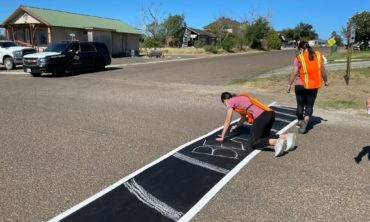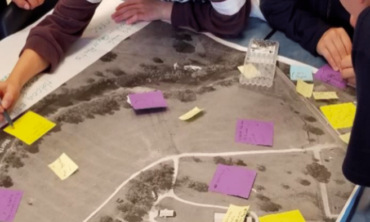By Anna Stehling
When planning for community change and improvement, it’s easy to overlook a segment of the population that is often underrepresented among community planners and professionals: youth.
Those under 25 have a unique experience and perspective in their community and often aren’t scared to speak the truth about what they see. If you want to make a change in your community that is impactful, meaningful, relevant, and sustainable, engage the community, including the youth.

FACES OF OUR PAST, PRESENT, AND FUTURE
Changemakers around the world tap into younger generations for their outlook and input. For example, as Kailash Satyarthi campaigned against child labor in India, he made sure to include the children and youth impacted by these situations. For the social reforms he helped bring about, he was co-recipient of the Nobel Peace Prize, along with Malala Yousafzai, in 20141.
His perspective is captured here: “The power of youth is the common wealth for the entire world. The faces of young people are the faces of our past, our present, and our future. No segment in the society can match with the power, idealism, enthusiasm, and courage of the young people.2”
As you look to make a difference in your community, whether large or small, embracing the power of youth perspective can shape your outcomes in positive ways.


MEANINGFUL PERSPECTIVES
Youth participation and engagement are important to a meaningful planning process for myriad reasons. Not only are young people the future of the community, but they are here right now, and their opinions matter. Regardless of age, all people have experiences and opinions that are valid. Youth community members have a right to be included in decisions that will affect them.
Bringing youth to the table and giving them a voice and an opportunity to contribute to change also can foster a sense of ownership and belonging. Young people that are involved in their community change will likely feel a sense of investment in their community and will develop a sense of ownership and pride there as well.
Young people experience and view their community in a way that is unique, which makes them a significant group to tap into. Community leaders should capitalize on the fact that youth have a one-of-a-kind lens through which they view their surroundings.

OBSTACLES TO OVERCOME
Why don’t we embrace the power of the youth perspective more often? Perhaps it’s that community leaders look to professional peers, who are often older. It also takes a concerted effort to engage young people and figure out where to find them. There also might be preconceived ideas about what they care about and how involved they want to be. Keep an open mind–you will probably be surprised.
CONNECTING WITH YOUTH
It can help if you understand a few things about the younger generations by talking to them. Here are some ideas for getting in touch:
· Reach out to current contacts about the young people in their lives.
· Connect with local high school guidance counselors and ask for their recommendations about how to interest students in your goals.
· Utilize social media to reach younger generations (Instagram is a good start).
· Put up flyers at the places where youth gather, like libraries and community sports venues.
Once you have a handful of young people interested, let them plan a fun event and invite their friends. Pizza, anyone?
PLAN TO SUCCEED
Aiming to increase youth engagement and participation can be woven into your efforts as you work to change your community. Participation might start off small, but incorporating youth in your efforts will likely strengthen it for the future. Think long-term, make use of your connections, and stay optimistic: Your community, young and old, will benefit.






Sources
1 https://en.wikipedia.org/wiki/Kailash_Satyarthi
2 https://www.forbesindia.com/article/thoughts/thoughts-on-being-young/66673/1





 There are three important sectors that will be used to coordinate these efforts: Communication, nutrition/food systems, and physical activity. Communication will help engage, inform, and educate coalition and community members to make healthy living easier by joining listservs and participating in webinars. Coalition members will also write and adopt organizational level healthy nutrition standards in institutions such as hospitals, after-school and recreation programs, health centers, faith-based organizations, food pantries, and early care education. (CDC Implementation Guide) In addition, coalition members will collaborate with partners and subject matter experts to improve the food system and increase access to healthier foods by attending workshops, requesting technical assistance, and acquire tool kits to work in teams and community groups to improve local food systems: distribution, procurements and sales, food hubs and outlets, purchasing collective, innovative practices. Finally, coalition members will learn best practices for organizational and community opportunities to develop active-friendly routes by improving local connectivity and active friendly routes and places through planning, policies, and environmental design. (CDC Implementation Guide)
There are three important sectors that will be used to coordinate these efforts: Communication, nutrition/food systems, and physical activity. Communication will help engage, inform, and educate coalition and community members to make healthy living easier by joining listservs and participating in webinars. Coalition members will also write and adopt organizational level healthy nutrition standards in institutions such as hospitals, after-school and recreation programs, health centers, faith-based organizations, food pantries, and early care education. (CDC Implementation Guide) In addition, coalition members will collaborate with partners and subject matter experts to improve the food system and increase access to healthier foods by attending workshops, requesting technical assistance, and acquire tool kits to work in teams and community groups to improve local food systems: distribution, procurements and sales, food hubs and outlets, purchasing collective, innovative practices. Finally, coalition members will learn best practices for organizational and community opportunities to develop active-friendly routes by improving local connectivity and active friendly routes and places through planning, policies, and environmental design. (CDC Implementation Guide)